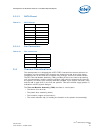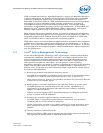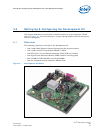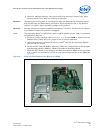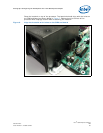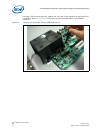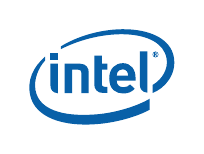
Intel
®
Q965 Express Chipset
October 2007 DM
Order Number: 315664-002US 30
Development Kit Software and BIOS Features—Intel Q965 Express Chipset
IEGD is created specifically for embedded platforms, offering an adaptable alternative
to drivers designed for the desktop market segments. IEGD offers Intel's embedded
customers extended life support that correlates with the extended life support of
Embedded IA-32 silicon products. IEGD differentiates itself through its configurability
and support of unique embedded market segment requirements, including an
unprecedented support of advanced display combinations, non-standard display
dimensions, and embedded operating systems such as Microsoft* XP Embedded and
WePOS.The Intel
®
Graphics Media Accelerator (GMA) is designed for mainstream
desktop usage models focusing on 3D performance and ease of use.
When working with external graphics drivers, the internal graphics will automatically
disable. When a discrete graphics card is plugged into to the graphics port (PEG), the
integrated graphics will be disabled. Note that this does not apply to an ADD2 card,
which is intended to work in conjunction with integrated graphics.
IEGD allows support of external discrete graphics cards in conjunction with integrated
graphics when a discrete graphics card is plugged into the PCI Express* x1 or PCI at
the ICH. If you have a discrete graphics card plugged into the PCI Express*, it will work
in conjunction with the integrated graphics. Note that GMA drivers will not support this,
only the IEGD drivers.
3.4 Intel
®
Active Management Technology
Intel
®
Active Management Technology (AMT) offers tamper-resistant and persistent
management capabilities. Specifically, Intel AMT is a hardware-based solution that
offers encrypted and persistent asset management and remote diagnostics and/or
recovery capabilities for networked platforms. With Intel AMT, IT organizations can
easily get accurate platform information, and can perform remote updating,
diagnostics, debugging, and repair of a system, regardless of the state of the operating
system and the power state of the system. Intel AMT enables IT organizations to
discover, heal, and protect all of their computing assets, regardless of system state in
the manner described below.
(1) Discovering hardware and software computing assets:
• Intel AMT stores hardware and software asset information in non-volatile memory
and allows IT to read the asset information anytime, even if the PC is off.
• Users cannot remove or prevent IT organization access to the information because
it does not rely on software agents.
(2) Healing systems remotely, regardless of the operating system or system state:
• Intel AMT provides out-of-band diagnostics and recovery capabilities for IT
organizations to remotely diagnose and repair PCs after software, operating
system, or hardware failures.
• Alerting and event logging help IT organizations detect and diagnose problems
quickly to reduce end-user downtime.
(3) Protecting the enterprise against malicious software attacks:
• Intel AMT helps IT organizations keep software versions and virus protection
consistent and up-to-date across the enterprise.
• Version information is stored in non-volatile memory for access anytime by third-
party software to check and, if necessary, wake a system to perform off-hours
updates.
(4) The key features of Intel AMT include:
• Secure Out of Band (OOB) system management that allows remote management of
PCs regardless of system power or operating system state.





